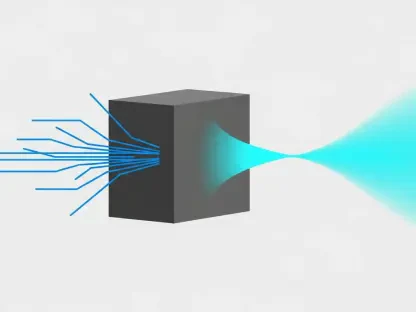The cutting-edge research conducted by both Princeton and MIT researchers has paved the way for a groundbreaking innovation in cross-medium eavesdropping technology, revolutionizing our previous understanding of underwater communication security. Historically, the distinct physical properties of water and air were believed to naturally protect underwater communications from interception—an assumption now profoundly challenged by this new technology. This pioneering advancement allows for the interception of underwater acoustic signals, commonly referred to as sonar, from airborne platforms through the use of radar technology.
The Physics of Underwater Sound Propagation
Traditionally, underwater communications have been inherently secure due to the physics of sound propagation in water. Sound waves carrying vital information encounter a natural barrier upon reaching the water’s surface, a consequence of the different densities between water and air. As a result, these waves typically reflect off the surface rather than penetrating it, creating a natural shield for underwater messages. Over time, this phenomenon has led to the belief that underwater communications were inherently protected and secure.
However, the research team from Princeton and MIT has developed a method that defies this long-held assumption. By utilizing radar technology to read the subtle vibrations on the water’s surface induced by submerged sonar signals, they have devised a system capable of eavesdropping on underwater communications from the air. These extraordinary findings were meticulously documented in a paper presented at ACM MobiCom on November 20. The implications of this technology are far-reaching, touching on aspects from national security to the protection of critical infrastructure, including climate monitoring systems and underwater oil and gas facilities.
Evolution of Cross-Medium Communication
The leap towards this innovation can be traced back to 2018 when the MIT team developed an initial system that enabled communication between underwater and airborne devices. This earlier system required prior collaboration and a shared understanding of technical specifications such as data rates and frequencies. By contrast, the current advancement discards the necessity for such cooperation, permitting interception without any previous knowledge of these vital parameters. This breakthrough significantly expands the potential scope of eavesdropping applications, thereby raising serious concerns about the security of previously thought secure underwater transmissions.
A critical element of this technological leap is the mechanism to translate surface vibrations back into coherent underwater messages. Detecting these minute vibrations necessitates the use of highly sensitive radar equipment and advanced algorithms to decode the patterns into intelligible information. Building upon MIT’s foundational innovations, the Princeton team has crafted new computational techniques that identify crucial transmission parameters like modulation type and frequency. This capability underscores the system’s versatility in decoding messages, even in the absence of insider knowledge about the specifics of the transmission.
Field Testing and Real-World Applications
To validate the functionality of their system, the researchers conducted extensive field testing in both controlled environments, such as swimming pools, and natural settings, notably Lake Carnegie in Princeton. These experiments revealed that the system could accurately identify and decode underwater messages despite the presence of environmental interferences like wind and wave actions. With a remarkable accuracy rate of 97.58% in decoding modulation types, the system demonstrated its robustness and reliability in real-world applications.
However, deploying this technology in more complex environments, such as the open ocean, poses considerable challenges. The researchers emphasize that while such deployment is technically feasible, it would require significant engineering advancements to ensure effective operation under these conditions. The technology currently relies on commercially available, standard equipment, suggesting that more sophisticated versions of the system could achieve even greater levels of efficiency and effectiveness in the future.
Implications for National Security and Critical Infrastructure
The practical ramifications of this technological breakthrough are profound and far-reaching. If adversaries are able to intercept sensitive underwater communications, it could put critical information at significant risk. Data from climate sensors, oil rigs, and even military submarines could potentially be compromised. This newly introduced cross-medium eavesdropping capability represents a novel threat vector for cyber and physical security, highlighting the urgent need for increased vigilance and enhanced security measures for underwater communication channels.
Despite these concerning vulnerabilities, the researchers offer a glimmer of hope by suggesting strategies to counteract this new form of eavesdropping. They propose countermeasure techniques designed to render underwater acoustic transmissions more resilient against such interception efforts. Through enhanced design parameters and defense methods, the integrity of underwater communication systems can be fortified, providing a more secure transmission medium.
The Need for Reevaluation and Future Directions
Researchers from Princeton and MIT have unveiled a revolutionary innovation in cross-medium eavesdropping technology, fundamentally altering our understanding of underwater communication security. Previously, it was believed that the unique physical properties of water and air provided natural protection against the interception of underwater communications. This assumption has been significantly challenged by the new technology. Historically, sonar, the underwater acoustic signals, was deemed secure from airborne interception. However, with this cutting-edge development, it is now possible to intercept these underwater acoustic signals using radar technology from airborne platforms. This pioneering advancement has significant implications, as it allows for underwater communications, which were once thought to be inherently secure due to the medium they travel through, to be accessed and potentially compromised by adversaries. The work carried out by these leading institutions not only demonstrates a remarkable feat in science and engineering but also signifies a paradigm shift in the field of underwater communication security.









